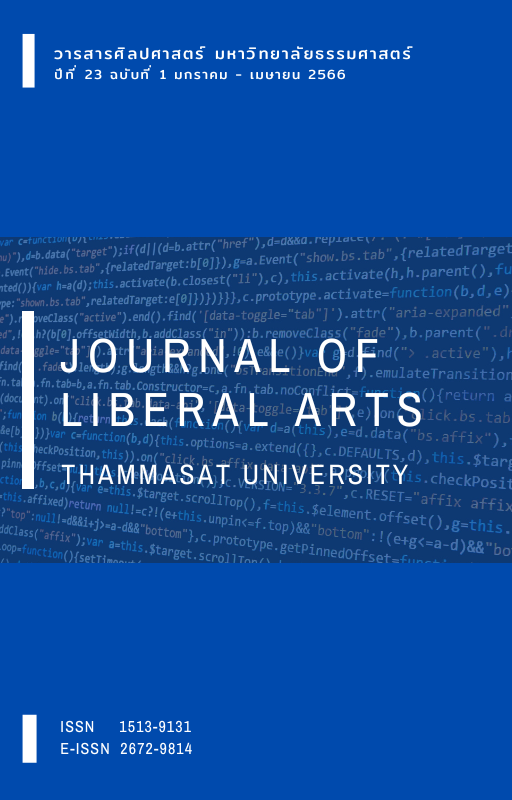Semantic Properties of the Polysemous Word, /khɨn3/ ‘ascend’, in Thai
Main Article Content
Abstract
This article aims to analyze and categorize the meanings of the word /khɨn3/ in Thai from the cognitive semantic and principled polysemy approaches. The results reveal that the word /khɨn3/ can convey 13 meanings: 1) ‘moving upward’; 2) ‘upward direction of motion’; 3) ‘direction of change-of-state event’; 4) ‘change-of-state event /caused change-of-state event’; 5) ‘to appear’; 6) ‘having a state’; 7) ‘increasing quantity or quality’; 8) ‘moving to a higher level or status’; 9) ‘being at a higher level’; 10) ‘to grow’; 11) ‘more than’; 12) ‘to start’; and 13) ‘in accordance with, conforms or belongs to’.
Downloads
Article Details

This work is licensed under a Creative Commons Attribution-NonCommercial-NoDerivatives 4.0 International License.
References
จรรยวรรณ สุวรรณรัตน์. (2558). การใช้กริยารองบอกทิศทางแบบไม่บ่งชี้ ขึ้น และ ลง ในภาษาไทย โดยผู้พูดภาษาอังกฤษที่เรียนภาษาไทยเป็นภาษาที่สอง [วิทยานิพนธ์ปริญญาดุษฎีบัณฑิต]. จุฬาลงกรณ์มหาวิทยาลัย.
ภคภต เทียมทัน. (2561). พัฒนาการของคำว่า “บน” ในภาษาไทย: การศึกษาตามแนวคิดอรรถศาสตร์ปริชาน [วิทยานิพนธ์ปริญญาดุษฎีบัณฑิต]. จุฬาลงกรณ์มหาวิทยาลัย.
สิริกมล สิริสัมพันธ์, และ ชัชวดี ศรลัมพ์. (2564). การแสดงความหมายในเหตุการณ์การเคลื่อนที่จริงของคำว่า 起 (qǐ ขึ้น) ในภาษาจีนกลาง. วารสารภาษาและภาษาศาสตร์, 39(2), 1-30.
โสภาวรรณ แสงไชย. (2537). กริยารอง ขึ้น และ ลง ในภาษาไทย [วิทยานิพนธ์ปริญญามหาบัณฑิต]. จุฬาลงกรณ์มหาวิทยาลัย.
อมรา ประสิทธิ์รัฐสินธุ์. (2553). ชนิดของคำในภาษาไทย: การวิเคราะห์ทางวากสัมพันธ์. โรงพิมพ์จุฬาลงกรณ์มหาวิทยาลัย.
อัญชลี สิงห์น้อย. (2548). คำนามประสม: ศาสตร์และศิลป์ในการสร้างคำไทย. สำนักพิมพ์แห่งจุฬาลงกรณ์มหาวิทยาลัย.
Evans, V., & Green, M. (2006). Cognitive Linguistics: An Introduction. Edinburgh University Press.
Lakoff, G. (1987). Woman, fire and dangerous things: What categories reveal about the mind. University of Chicago Press.
Ravin, Y., & Leacock, C. (2000). Polysemy: Theoretical and Computational Approaches. Oxford University Press.
Tyler, A., & Evans, V. (2003). The Semantics of English Prepositions: Spatial Scenes, Embodied Meaning and Cognition. Cambridge University Press.

